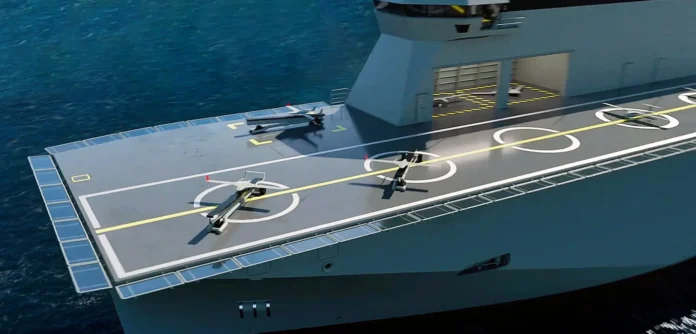Forget everything you thought you knew about naval aviation. The next generation of warships isn’t focused on multi-billion-dollar aircraft carriers that carry crewed fighter jets, but on something far more futuristic: drone carriers. These uncrewed air system (UAS) vessels are changing the game, offering navies across the globe a cost-effective way to project power at sea, all while avoiding the risks tied to traditional, manned carriers.
You might think of drones as a technology that’s mostly confined to land-based military operations, but navies are quickly realising the strategic value of integrating these uncrewed systems into their fleets. What’s even more fascinating is that drone carriers aren’t just for rising powers or nations with limited resources, they’re appealing to even the most established naval forces, including those with full-size aircraft carriers.
Drone Carriers: A Smarter, Cheaper Alternative
While the Royal Navy and other established fleets already operate aircraft carriers, they’re keen to jump on the drone carrier bandwagon. But for many smaller nations, purchasing a full-sized carrier to operate crewed jets is simply out of reach. Enter drone carriers, which provide a way to achieve some level of naval air power without the sky-high price tags.
China, for example, is making strides with its own prototype. The Zhong Chuan Zi Hao, a large vessel believed to be a drone carrier, was launched in November 2024. Its design is impressive: a three-island configuration with a flight deck ready for Vertical Take-Off and Landing (VTOL) UAS operations. Whether it’s meant for frontline deployment or simply as a testbed for further innovation, the Zhong Chuan Zi Hao is a significant move in the race for drone carrier dominance.
Iran’s No-Frills Approach
On the flip side, Iran is taking a more affordable route with its drone carrier program. The country has retrofitted merchant vessels and corvettes to create low-cost platforms capable of carrying long-range drones. The IRIS Shahid Bahman Bagheri, a container ship converted into a drone carrier, is a prime example. While its flight deck is a bit unconventional, this vessel is already a tool for extended surveillance and strike operations across the Gulf, with a range that could extend into the Red Sea and Mediterranean.
What’s striking here isn’t just the cost-effectiveness, but the way Iran’s use of drone carriers enhances its asymmetric naval warfare capabilities. These ships are less about conventional combat and more about projecting power, using drones to gather intelligence or even launch strikes from the safety of an uncrewed platform.
Turkey’s Innovative Shift
Turkey’s adaptation of its LHD (Landing Helicopter Dock) ship, TCG Anadolu, to carry drones is another exciting twist in this trend. Initially designed to carry F-35B jets, the ship was repurposed after Turkey’s expulsion from the F-35 program. Now, it hosts the Bayraktar TB3 drone, a navalised version of Turkey’s successful TB2 UAS, and will potentially carry jet-powered UAVs like the Kızılelma in the future.
Turkey’s agility in pivoting from traditional military platforms to a drone-centric naval strategy shows just how quickly nations can adapt when they embrace innovation. In the coming years, TCG Anadolu could be the forerunner of an entire fleet of drone-capable vessels, reshaping Turkey’s naval operations.
Portugal’s Flexible Multi-Use Platform
Not to be left behind, Portugal is also joining the drone carrier race. The NRP D. João II, a ship designed to support a range of missions from disaster relief to environmental monitoring, is being built with uncrewed systems in mind. With a flight deck and integrated UAS hangars, it’s a versatile platform that could evolve as drone technology advances, positioning Portugal as a key player in naval innovation.
Brazil and the Practicalities of UAS
Brazil’s decision to test drones from the NAM Atlântico, a former UK helicopter carrier, further demonstrates how large-deck ships can be adapted to support UAV operations. Although the ScanEagle drone it has trialled isn’t the most sophisticated option, it’s a solid example of how nations with more modest naval ambitions are tapping into the drone trend.
Navigating the Challenges Ahead
Of course, the rise of drone carriers comes with its challenges. Integrating uncrewed systems into naval operations isn’t a straightforward task. Launching and recovering drones at sea, especially in rough conditions, is still a work in progress. Additionally, securely commanding a fleet of drones without the risk of jamming or disruption adds complexity to their use in combat.
Despite these hurdles, the future of drone carriers is undeniably exciting. As the technology matures and more nations invest in uncrewed systems, drone carriers may become just as integral to modern fleets as traditional aircraft carriers have been in the past. The concept of sea-based air power is being redefined, and drone carriers could soon become the new norm for many naval forces worldwide.
What Does This Mean for the Future?
Ultimately, the rise of drone carriers isn’t just about replacing traditional aircraft carriers. It’s about flexibility, cost-effectiveness, and survivability in a rapidly changing naval landscape. Drone carriers could allow countries to scale their naval air power in ways that were previously unimaginable, and while the larger, crewed carriers may still hold their place, drones are paving the way for a new era of naval dominance.
















